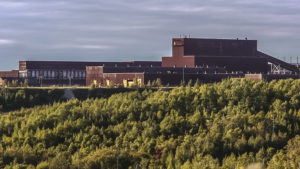October 10, 2019
Comprehensive on-site monitoring maintains high water quality standards
Share
Becoming the first company fully permitted to develop and operate a copper-nickel-precious metals mine in northeastern Minnesota in March 2019 was a monumental achievement for PolyMet and northern Minnesota. It set us on a path toward bringing more jobs to the region, stimulating our state’s economy and operating a responsible mine.
Our permits were reviewed carefully and approved by state and federal agencies, each of whom found our plans to meet strict regulations and compliance measures – far more than any other permitted mine in Minnesota. As a modern mine, we are being held to a higher standard, and our permits prove we are up to the task.
Producing essential metals and being a responsible steward of Minnesota’s water and air quality, lands, and public health are our top priorities. We are committed to meeting all permit conditions for the duration of the NorthMet project.
Water is one of Minnesota’s most treasured resources, and we take our responsibility for water quality on the NorthMet project site very seriously. While the project is not yet operational, we have already made significant investments in water quality monitoring infrastructure.
“We’re currently monitoring more than 200 sites throughout both the mine and plant sites in accordance with our permits, and this number will increase to over 300 sites once we’re in operations,” explained Christie Kearney, environmental site director. “This has allowed us to establish an understanding of the baseline conditions, so we can ensure our operation maintains high water quality standards at every phase.”
Our monitoring efforts can be categorized into three groups:
- Compliance Monitoring
Our compliance monitoring efforts generally take place at or near property boundaries, where the project will show compliance. Results show us important data on water that enters and leaves the project site. - Indicator Monitoring
We’ve placed indicator monitors at locations between the compliance stations and project features to allow for early detection of potential project impacts. They’re a proactive measure that informs our operations strategy. - Performance Monitoring
We keep a close eye on the performance of engineering infrastructure (like liner systems or containment systems). Performance monitoring stations include individual monitoring wells, paired monitoring wells, paired piezometers and stockpile underdrains.
 Additionally, the NorthMet project will rehabilitate, modernize and reuse much of the existing infrastructure of the former LTV Steel taconite processing site, which has been sitting idle for nearly 20 years. Using this site came with extra requirements to address legacy mining issues that currently impact the environment. Our monitoring, controls and treatment activities will ensure that this site improves its water quality and overall environmental health, resulting in a net reduction of several pollutants, including mercury and sulfate, currently found in the St. Louis River.
Additionally, the NorthMet project will rehabilitate, modernize and reuse much of the existing infrastructure of the former LTV Steel taconite processing site, which has been sitting idle for nearly 20 years. Using this site came with extra requirements to address legacy mining issues that currently impact the environment. Our monitoring, controls and treatment activities will ensure that this site improves its water quality and overall environmental health, resulting in a net reduction of several pollutants, including mercury and sulfate, currently found in the St. Louis River.
By monitoring both surface water and groundwater at our mine and plant sites now, we’re growing our understanding of all on-site water so we can make sure our site operates within all federal and state regulations. We will also report our monitoring data to agencies, as is outlined in our permits. This ensures our project will remain transparent and in compliance at all times.
Our plans and permits show our commitment and ability to protect human health and the environment now and for years to come.
 Meet Our Team: Christie Kearney joined PolyMet as an environmental site director in 2016, bringing with her nearly two decades of experience in environmental permitting and compliance and water resources engineering in both consulting and industry, with over 10 years concentrated on the mining industry. She has served on the Society of Mining Metallurgy and Exploration (SME) Professional Engineering Exam Committee since 2012, working on reclamation and environmental questions for the PE exam for the mining and mineral processing exam. Christie holds a master’s degree in civil engineering from the University of Minnesota, Twin Cities. She is a second-generation miner from nearby Hibbing and was excited to move back to the Iron Range from Alaska in 2006, bringing her husband and two daughters who share her love for the outdoors.
Meet Our Team: Christie Kearney joined PolyMet as an environmental site director in 2016, bringing with her nearly two decades of experience in environmental permitting and compliance and water resources engineering in both consulting and industry, with over 10 years concentrated on the mining industry. She has served on the Society of Mining Metallurgy and Exploration (SME) Professional Engineering Exam Committee since 2012, working on reclamation and environmental questions for the PE exam for the mining and mineral processing exam. Christie holds a master’s degree in civil engineering from the University of Minnesota, Twin Cities. She is a second-generation miner from nearby Hibbing and was excited to move back to the Iron Range from Alaska in 2006, bringing her husband and two daughters who share her love for the outdoors.
August 2, 2019
In northeastern Minnesota, communities stick together – and we know we’re strongest when cit... read more
July 11, 2019
When the U.S. Army Corps of Engineers issued its Record of Decision and wetlands permit for the Nort... read more
May 21, 2019
After more than 10 years of diligent environmental and regulatory work, we have succeeded in securin... read more
April 1, 2019
If you were around the Hoyt Lakes area last fall, you likely noticed more activity at the NorthMet p... read more


